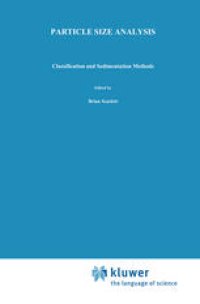
Ebook: Particle Size Analysis: Classification and sedimentation methods
Author: Claus Bernhardt (auth.)
- Tags: Characterization and Evaluation of Materials
- Series: Powder Technology Series 5
- Year: 1994
- Publisher: Springer Netherlands
- Edition: 1
- Language: English
- pdf
teacher Professor Ernst-Joachim Ivers to whom I still owe many insights 20 years after the end of his working life. This English edition is not an unedited translation of the German edition of 1990. The text has been substantially revised in some chapters, taking into account the literature published in the mean time. I wish to thank Dr.-Ing. H. Finken, Freiberg, who has prepared the translation from German into English with deep scientific understanding and in close contact with the author. I also wish to express my gratitude to Chapman & Hall for their support to this project without which the English edition could not have been published. Dr.-Ing. habil. C. Bernhardt Freiberg 1 Position, tasks and structure of particle size analysis Today the concept of particle size analysis is that of a special field of particle measurement technology, which in turn is part of particulate technology. This classification has developed over the last 20 years; it is the result of a scientific integration process taking place in many industrialized countries of the world. In recent years, the meaning and mutual connection of the related concepts as well as the tasks of the scientific disciplines designated by them have been the subject of intensive discussion which, however, has not led to a generally accepted terminology.
This text will be of interest to all those concerned with the preparation, processing and analysis of disperse systems. There is a wide range of methods and devices available for providing information on the quantitative distribution of the characteristics of particle size and shape obtainable: choosing which one is not easy. This work will prove to be an invaluable source of reference for powder technologists, as well as graduates and researchers.
This text will be of interest to all those concerned with the preparation, processing and analysis of disperse systems. There is a wide range of methods and devices available for providing information on the quantitative distribution of the characteristics of particle size and shape obtainable: choosing which one is not easy. This work will prove to be an invaluable source of reference for powder technologists, as well as graduates and researchers.
Content:
Front Matter....Pages i-xii
Position, tasks and structure of particle size analysis....Pages 1-7
Introduction to classification....Pages 8-15
Particle movement in a fluid at rest....Pages 16-75
Dispersion of solids in liquids....Pages 76-108
Sedimentation....Pages 109-160
Classification methods in streaming fluids....Pages 161-196
Sieving....Pages 197-239
Evaluation, representation and use of results....Pages 240-278
Back Matter....Pages 279-428
This text will be of interest to all those concerned with the preparation, processing and analysis of disperse systems. There is a wide range of methods and devices available for providing information on the quantitative distribution of the characteristics of particle size and shape obtainable: choosing which one is not easy. This work will prove to be an invaluable source of reference for powder technologists, as well as graduates and researchers.
Content:
Front Matter....Pages i-xii
Position, tasks and structure of particle size analysis....Pages 1-7
Introduction to classification....Pages 8-15
Particle movement in a fluid at rest....Pages 16-75
Dispersion of solids in liquids....Pages 76-108
Sedimentation....Pages 109-160
Classification methods in streaming fluids....Pages 161-196
Sieving....Pages 197-239
Evaluation, representation and use of results....Pages 240-278
Back Matter....Pages 279-428
....